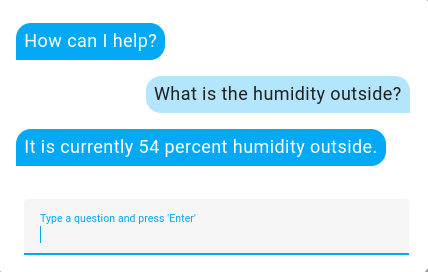Conversation
The Conversation integrationIntegrations connect and integrate Home Assistant with your devices, services, and more. [Learn more] allows you to converse with Home Assistant. You can either converse by pressing the microphone in the frontend (supported browsers only (no iOS)) or by calling the conversation.process action with the transcribed text.
 Screenshot of the conversation interface in Home Assistant.
Screenshot of the conversation interface in Home Assistant.
# Example base configuration.yaml entry
conversation:
Default sentences
By default, a collection of community contributed sentences
In English, you can say things like “turn on kitchen lights” or “turn off lights in the bedroom” if you have an area named “bedroom”.
Adding custom sentences
You can add your own sentence templates to teach Home Assistant about new sentences. These sentences can work with the built-in intents or trigger a custom action by defining custom intentsIntent is a term used with voice assistants. The intent is what Home Assistant thinks you want it to do when it extracts a command from your voice or text utterance. [Learn more] with the intent script integration.
To get started, create a custom_sentences/<language> directory in your Home Assistant config directory where <language> is the language code of your language, such as en for English. These YAML files are automatically merged, and may contain intents, lists, or expansion rules.
For an English example, create the file config/custom_sentences/en/temperature.yaml and add:
# Example temperature.yaml entry
language: "en"
intents:
CustomOutsideHumidity:
data:
- sentences:
- "What is the humidity outside"
To teach Home Assistant how to handle the custom CustomOutsideHumidity intentIntent is a term used with voice assistants. The intent is what Home Assistant thinks you want it to do when it extracts a command from your voice or text utterance. [Learn more], create an intent_script entry in your configuration.yamlThe configuration.yaml file is the main configuration file for Home Assistant. It lists the integrations to be loaded and their specific configurations. In some cases, the configuration needs to be edited manually directly in the configuration.yaml file. Most integrations can be configured in the UI. [Learn more] file:
# Example configuration.yaml entry
intent_script:
CustomOutsideHumidity:
speech:
text: "It is currently {{ states('sensor.outside_humidity') }} percent humidity outside."
More complex actions can be done in intent_script, such as performing actions and firing events.
Extending built-in intents
Extending the built-in intentsIntent is a term used with voice assistants. The intent is what Home Assistant thinks you want it to do when it extracts a command from your voice or text utterance. [Learn more], such as HassTurnOn and HassTurnOff, can be done as well.
For example, create the file config/custom_sentences/en/on_off.yaml and add:
# Example on_off.yaml entry
language: "en"
intents:
HassTurnOn:
data:
- sentences:
- "engage [the] kitchen lights"
slots:
name: "kitchen lights"
HassTurnOff:
data:
- sentences:
- "disengage [the] kitchen lights"
slots:
name: "kitchen lights"
Now when you say “engage the kitchen lights”, it will turn on a light named “kitchen lights”. Saying “disengage kitchen lights” will turn it off.
Let’s generalize this to other entities. The built-in {name} and {area} lists contain the names of your Home Assistant entities and areas.
Adding {name} to config/custom_sentences/en/on_off.yaml:
# Example on_off.yaml entry
language: "en"
intents:
HassTurnOn:
data:
- sentences:
- "engage [the] {name}"
HassTurnOff:
data:
- sentences:
- "disengage [the] {name}"
You can now “engage” or “disengage” any entity.
Lastly, let’s add sentences for turning lights on and off in specific areas:
# Example on_off.yaml entry
language: "en"
intents:
HassTurnOn:
data:
- sentences:
- "engage [the] {name}"
- sentences:
- "engage [all] lights in [the] {area}"
slots:
name: "all"
domain: "light"
HassTurnOff:
data:
- sentences:
- "disengage [the] {name}"
- sentences:
- "disengage [all] lights in [the] {area}"
slots:
name: "all"
domain: "light"
It’s now possible to say “engage all lights in the bedroom”, which will turn on every light in the area named “bedroom”.
Action conversation.process
Send a message to a conversation agent for processing.
| Data attribute | Optional | Description |
|---|---|---|
text |
no | Transcribed text input |
language |
yes | Language of the text |
agent_id |
yes | ID of conversation agent. The conversation agent is the brains of the assistant. It processes the incoming text commands. |
conversation_id |
yes | ID of a new or previous conversation. Will continue an old conversation or start a new one. |
This action is able to return response data. The response is the same response as for the
/api/conversation/process API.
Action conversation.reload
| Data attribute | Optional | Description |
|---|---|---|
language |
yes | Language to clear intent cache for. No value clears all languages |
agent_id |
yes | ID of conversation agent. Defaults to the built-in Home Assistant agent. |